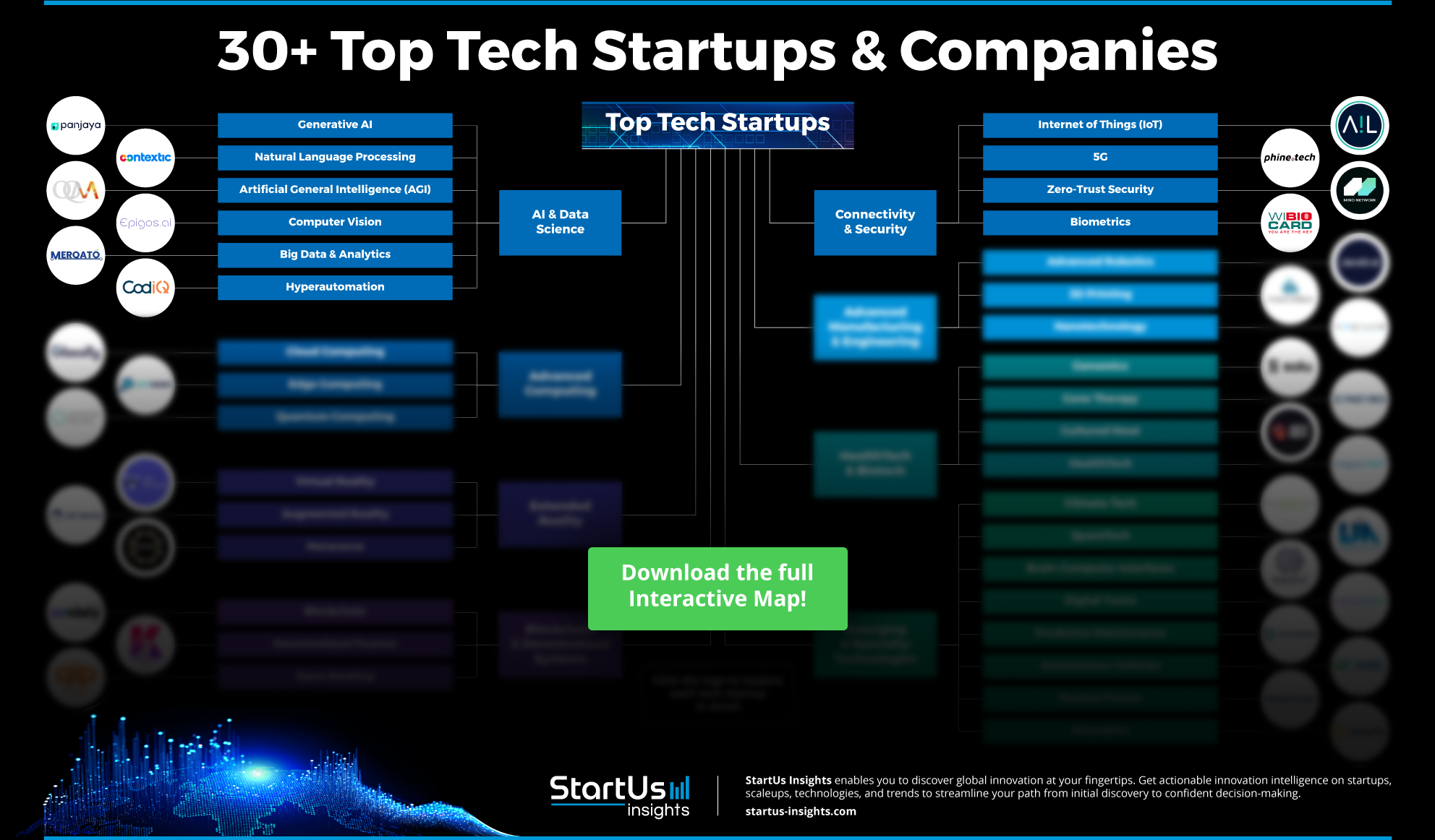Semiconductors are one of the most widely used products in all industries. It is driving several technological developments in sectors like consumer electronics, automotive, and industrial applications. Although it is one of the oldest and most conventional building blocks used in every conducting application, the current innovations in this industry are focused on improving the conducting potential of the semiconductor and introducing energy-efficient ways to mass produce them.
This article provides data-driven information about the contribution of major technologies like AI, big data, and nanotechnology in the semiconductor industry. Read along to find how these technologies are improving semiconductor properties like thermal conductivity, particle mobility, durability, etc. Also, find out how these improved features are making semiconductors suitable for application in fields like quantum computing.
Why should you read this report?
- Gain in-depth insights into the top 10 emerging semiconductor technologies
- Learn about three practical use cases for each technology
- Meet 10 innovative startups advancing these technologies
![]()
Key Takeaways
- 3D Printing
- Use Cases:
- Prototyping
- Customization
- Packaging and Encapsulation
- Startup to Watch: Syenta
- Use Cases:
- Artificial Intelligence
- Use Cases:
- Chip Design
- Manufacturing Process Optimization
- Startup to Watch: BFAI Semiconductor Solutions
- Use Cases:
- AR and VR
- Use Cases:
- Training
- Assembly, Maintenance, Repair
- Remote Collaboration
- Startup to Watch: Lavorro
- Use Cases:
- Big Data and Analytics
- Use Cases:
- Yield Analysis and Optimization
- Customer Analysis
- Research and Development
- Startup to Watch: Innowave Tech
- Use Cases:
- Advanced Materials
- Use Cases:
- Electrical Conductivity
- Structural Modification
- Transistor Manufacturing
- Startup to Watch: Black Semiconductor
- Use Cases:
- Cleantech
- Use Cases:
- Water Conservation
- Low Energy Consumption
- Chemical Usage Reduction
- Startup to Watch: Purity Resource
- Use Cases:
- Connectivity Technologies
- Use Cases:
- Communication Infrastructure
- Real-Time Data Analytics
- Smart Logistics
- Startup to Watch: Packetcraft
- Use Cases:
- Internet of Things
- Use Cases:
- Automated Quality Control
- Energy Optimization
- Smart Packaging
- Startup to Watch: Dao Sensing Microelectronics
- Use Cases:
- Automation
- Use Cases:
- Manufacturing Automation
- Test Automation
- Cleanroom Automation
- Startup to Watch: Revolution EDA
- Use Cases:
- Nanotechnology
- Use Cases:
- Detailed Structure
- Superior Properties
- Small Semiconductor
- Startup to Watch: Aeluma
- Use Cases:
Semiconductor Industry FAQs
What are the biggest challenges affecting the semiconductor industry?
The semiconductor industry faces several challenges that affect its stability and growth. Supply chain disruptions, driven by geopolitical tensions and global events, continue to cause shortages and delayed production cycles. Additionally, the rising cost of raw materials and advanced equipment directly impacts profitability and increases capital investment requirements.
Another significant challenge lies in talent shortages, as the industry struggles to find skilled engineers and technicians to meet the demands of evolving technologies. Lastly, the increasing complexity of semiconductor design and manufacturing, particularly at smaller process nodes, requires more sophisticated techniques, which complicates production and drives up costs.
What are the newest semiconductor technologies and applications?
Recent advancements in semiconductor technologies include the development of 3D transistors and gate-all-around (GAA) architectures, which allow for higher performance and energy efficiency in smaller chips. Gallium nitride (GaN) and silicon carbide (SiC) materials have gained traction in power electronics. They offer better heat resistance and efficiency than traditional silicon-based components.
In terms of applications, semiconductors are now critical in the growth of artificial intelligence, where advanced chips enable faster processing of machine learning algorithms. Additionally, the expansion of 5G networks relies heavily on semiconductor advancements for enhanced speed and connectivity, while automotive innovations, such as autonomous driving and electric vehicles, increasingly depend on more powerful and efficient semiconductors.
Where We Get Our Data From
StartUs Insights gathers data through its exhaustive Discovery Platform, covering information on 4.7 million startups, scaleups, and tech companies globally, alongside 20,000 emerging technologies and trends. The Discovery Platform accelerates startup and technology scouting, trend intelligence, and patent searches, offering thorough insights into technological advancements. By leveraging the trend intelligence feature for this report, we identified emerging technologies within specific industries. This process allows us to uncover patterns and trends, and pinpoint relevant use cases and the startups creating solutions for each scenario. Additional capabilities and information can be found at StartUs Insights Discovery Platform.
10 Emerging Technologies Impacting the Future of Semiconductors [2025 & Beyond]
1. 3D Printing

3D printing enables the printing of three-dimensional structures in a more customized and intricate manner. It allows the amalgamation of different material properties like conductive, insulating, and dielectric to be deposited simultaneously in the same printer. 3D printing can produce different iterations of the final product within significantly less time. It reduces cost and makes the process streamlined and efficient. Products like wearable electronics, IoT devices, and medical implants that use semiconductors can be produced using 3D printers.
3 Practical Use Cases of 3D Printing in Semiconductor Industry
- Prototyping: 3D printing is used to rapidly prototype semiconductor devices like heatsinks, connectors, and housings. It allows faster prototyping of designs along with testing and trials for market release. In case of any anomaly or defect in the product, 3D printing creates an alternative piece with different properties within the least time. 3D printing makes semiconductor manufacturing time and cost-effective.
- Customization: 3D printing customizes semiconductors according to specific requirements. It produces specific fixtures, zigs, customized cooling systems, and tools required for building a semiconductor. It uses photolithography and etching processes to create complex tools that manufacture intricate designs and improve efficiency.
- Packaging & Encapsulation: Specialized semiconductors require custom packing and encapsulation methods. 3D printing creates packages with improved thermal management, mechanical protection, miniaturization, and other features. It also produces customized molds for special packing and encapsulation requirements.
Startup to Watch: Syenta
Syenta develops advanced manufacturing equipment that accelerates the production of high-performance semiconductor chips. It uses a patented electrochemistry-based process to reduce the number of steps in chip manufacturing. It also enables full-size panel and wafer deposition. The technology operates 100 times faster than conventional methods and delivers 90% of the conductivity of bulk copper. Currently, the technology can achieve a resolution of 4 µm. However the future target is to bring it down to 1 µm. Syenta minimizes environmental impact by using 98% less embodied energy and cutting CO2 emissions by 95% compared to photolithography.
2. Artificial Intelligence

AI covers a variety of applications in the semiconductor industry from predictive maintenance to design and manufacturing. The role of AI in LiDAR point cloud processing, image reconstruction through knowledge distillation, identifying structural defects, and implementing image processing algorithms further increases its application in addressing various challenges in the semiconductor industry. Additionally, AI is set to introduce a more sustainable and efficient semiconductor operation with its integration into specialized hardware solutions.
3 Practical Use Cases of AI in Semiconductor Industry
- Chip Design: AI-specific chips like GPUs (Graphic Processing Units), TPUs (Tensor Processing Units), and neuromorphic chips run on machine learning and deep learning techniques. It enables the optimization of neural networks in semiconductors.
- Defect Detection & Quality Control: Predictive modeling and anomaly detection allow manufacturers to analyze historical data and monitor real-time production to identify patterns that could indicate potential defects. AI-powered image recognition and machine learning algorithms identify defects during semiconductor manufacturing. AI also improves inspection accuracy, reduces manual intervention, and ensures higher quality control throughout production by analyzing wafer images and detecting microscopic flaws.
- Manufacturing Process Optimization: AI predicts equipment failure and reduces downtime in the semiconductor industry. The algorithm analyzes sensor data from manufacturing units to make the predictions. It ensures quality and consistency in the manufacturing unit. Besides optimizing the manufacturing process, AI also assists in detecting defects in semiconductor wafers or chips that are invisible to the human eye.
Startup to Watch: BFAI Semiconductor Solutions
BFAI Semiconductor Solutions specializes in AI products for the semiconductor industry. The defect classification AI module can be added to the AOI (Automated Optical Inspection) system. It contributes to semiconductor quality control and improves accuracy, efficiency, and reliability. The second product is the automated visual inspection AI system. It reduces human error by automating the verification of visual inspection after AOI. BFAI SEmiconductor Solutions also offers an AI platform for process optimization. It uses statistical mathematics and machine learning to improve the entire process. The platform detects anomalies and defects in real-time and suggests changes.
3. AR and VR

Immersive technologies create virtual prototypes of semiconductor devices to improve design and fabrication understanding. A controlled virtual setting improves the manufacturer’s skills and reduces the chances of errors. For example, the manufacturer can view the internal structure of the semiconductor by using a virtual space controller (space ball or glove) to rotate it, inspect it from a different angle, and change the miniature physical properties of the device.
3 Practical Use Cases of AR and VR in Semiconductor Industry
- Training & Skill Development: VR simulations create an immersive environment and replicate the semiconductor manufacturing process. It allows new employees to learn the procedures and protocols without the risk of damaging the equipment or disrupting the manufacturing process.
- Remote Equipment Maintenance: AR and VR enable collaboration in real-time. For example, experts in different parts of the world use AR to be virtually present at a manufacturing site to provide guidance troubleshoot errors, and oversee operations without needing to travel. AR also simulates all the operations and provides a systematic plan for the entire workflow. It overlays information like schematics, diagrams, and step-by-step instructions for the physical equipment. It also guides on-site personnel through the complex repair process.
- Design and Prototyping: Immersive technology compares the real-time view of the product with a digital model and highlights discrepancies or defects. AR and VR enable engineers to visualize and manipulate semiconductor designs in 3D to review and optimize complex chip layouts before fabrication. VR environments also simulate chip performance, which allows for more detailed testing of design iterations and early detection of potential flaws.
Startup to Watch: Lavorro
Lavorro delivers advanced augmented reality (AR) solutions for secure remote collaboration for semiconductor manufacturing. It utilizes real-time video feeds and interactive data. The company’s technology captures the local user’s view through headgear cameras, superimposes queried information via voice commands, and shares this feed with remote experts for real-time problem-solving. With the AR-driven interface, Lavorro significantly reduces mean time to repair (MTTR) and boosts productivity. This system is precious in industries requiring precise and immediate technical support.
4. Big Data and Analytics

The semiconductor industry uses a large volume and variety of data updated every minute. Big data analytics use the latest computing power, storage facility, and analytical techniques to analyze these data and deliver results. Big data analytics uncover hidden trends in market behavior, competitor’s activity, semiconducting materials, materials availability, etc, and help the semiconductor industry optimize overall operations.
3 Practical Use Cases of Big Data Analytics in Semiconductor
- Yield Analysis & Optimization: Big data analyzes information on lithography, etching, and deposition, and suggests the manufacturing process. The manufacturer improves the number of functional chips produced by using this data. The patterns generated by the analysis identify potential bottlenecks, optimize process parameters, yield outcomes, etc. The analytics also correlates yield loss with specific process or equipment conditions to better understand the entire process.
- Customer Analysis: Big data sheds light on customer patterns with its vast amount of generated data and assists the manufacturer in producing accordingly. It studies customer usage data and feedback to unravel trends and preferences. The manufacturers plan the raw material sourcing and supply chain management according to the data generated.
- Research & Development: The researchers use experimental data from the past, raw material availability, manufacturing processes, and the scope of semiconductor use to create innovative and technologically improved semiconductor designs. As a result, the semiconductor produced is more aligned with the modern requirements. Along with using the records, the researchers also record the current findings.
Startup to Watch: Innowave Tech
Innowave delivers intelligent semiconductor manufacturing solutions with an AI-integrated factory line that enables zero-defect maintenance. Its product Innosense uses advanced optical and IoT sensors to gather critical data from production lines and equipment, which provides actionable insights to resolve production bottlenecks and boost factory productivity. The NovRCM platform integrates factory-wide intelligence analysis through control towers and real-time monitoring. It gives the manufacturers optimized oversight of their processes. Innowave’s EQ Pulse system offers predictive maintenance by conducting equipment health diagnostics, reducing downtime, and increasing operational reliability. By combining data-driven insights with predictive tools, Innowave Tech ensures more efficient semiconductor manufacturing and sustainable operations.
5. Advanced Materials

With the increasing rise in semiconductor applications, new materials are being explored for manufacturing. Materials with better and application-specific qualities are finding a place in the semiconductor industry. For example, composite materials that combine the properties of 2 or more materials are being used to strengthen the integrated circuit and perform better. Another example is the use of silicon carbide and gallium nitride for their high electron mobility.
3 Practical Use Cases of Advanced Materials in Semiconductor Industry
- Electrical Conductivity: Graphene has high electrical conductivity, a crucial requirement for semiconductor products. Additionally, it ensures mechanical strength for small semiconductors. Because of its electron mobility capacity, Graphene is also used in interconnects and advanced sensors.
- Memory: PCMs are used for designing and fabricating unique structures that can monitor technology-specific parameters. PCMs have a higher data storage capacity than traditional flash memory, which ensures faster data transfer and improved connectivity. They are also used in non-volatile memory technologies like PCRAM.
- Transistor Manufacturing: Materials other than Graphene, such as black phosphorus, boron nitride, and transition metal dichalcogenides (TMDs), are used for transistor manufacturing. These materials have specific electronic and optical properties superior to conventional silicon or Graphene. These properties make them suitable for applications in quantum computing, flexible electronics, and spintronics.
Startup to Watch: Black Semiconductor
Black Semiconductor’s solution addresses limitations in traditional silicon-based chips by improving the processing power and reducing energy consumption, and manufacturing complexity. It develops ultra-fast, energy-efficient chips by combining electronics and photonics through its co-integrated optics (CIO) technology. This approach uses Graphene as a translator between electronic and optical signals and allows for superior chip-to-chip communication over long distances. Black Semiconductor’s technology aims to revolutionize industries like embedded AI and smart driving.

6. CleanTech

Since almost every industry uses semiconductors, the production rate and amount of semiconductors cannot be compromised. However, the production method can become sustainable. Semiconductor industries are integrating circular economy ideologies into their operations to promote reusability and recyclability to reduce waste production. The industry is also recovering and recycling end-of-life semiconductor products left after disassembling the circuit, which relaxes the mineral search for semiconductor manufacturing.
3 Practical Use Cases of Cleantech in Semiconductor Industry
- Water Conservation: Semiconductor manufacturing requires a large amount of water, especially for the wafer fabrication process. Within fabs, water treatment and recycling facilities are used to reduce water wastage and minimize freshwater consumption. Methods like Co2 cleaning and dry etching are also being explored to reduce the semiconductor industry’s water footprint.
- Low Energy Consumption: Semiconductor manufacturing requires attention to intricate design, making it an energy-intensive process. The industry is shifting towards developing low-power chips that consume less energy to prepare. The use of renewable energy to run semiconductor manufacturing is also rising to reduce dependency on environmentally harmful sources
- Chemical Usage Reduction: Using less toxic or easily recyclable material and implementing closed-loop chemical systems for semiconductor production are two prevalent methods for reducing harmful chemical production during semiconductor manufacturing. This reduces the environmental impact and ensures workers’ safety.
Startup to Watch: Purity Resource
Purity Resources develops a near-site, on-site, or on-tool Isopropanol Purification System. The semiconductor industry uses a lot of IPA, reusing which reduces the import requirement and promotes sustainability. The company polishes technical-grade or spent IPA to be introduced back into the electronic grade for reuse. The polishing is done by removing trace metals to parts per trillion and moisture to parts per million. The technology caters to different waste management challenges in the semiconductor industry. It can be customized to extract high water content from the drying process, eliminate high organic material from photoresist removal, and remove inorganic material from chemical mechanical polishing.
7. Connectivity Technologies

Connectivity technologies are essential in the semiconductor industry for facilitating communication, data transfer, and device integration. High-speed, low-latency, and high-bandwidth connections make these transactions smooth and streamlined. Connectivity technologies like Li-Fi networks, satellite communication, wireless connections, etc., ensure the uninterrupted functioning of semiconductors and their manufacturing industry.
3 Practical Use Cases of Connectivity Technologies in Semiconductor Industry
- Communication Infrastructure: 5G networks ensure low latency and high bandwidth communication. It is crucial in a manufacturing unit as there is continuous data transfer, machine-machine communication, and human-to-human communication. Wireless connectivity solutions like Wi-Fi 6 and private 5G networks support the mobility of connected devices within the semiconductor fabs. The infrastructure reconfigures production lines without extensive wiring and keeps the manufacturing unit safe.
- Real-Time Data Analytics: Edge computing devices near the manufacturing unit process data locally and in real time. This process reduces latency and allows faster decision-making. It also ensures immediate judgment of the manufacturing process based on data insights.
- Smart Logistics: Connectivity solutions like RFID and GPS let semiconductor manufacturers monitor the movements of raw materials and finished products in real time. Data recorded on the GPS optimizes transportation routes, reduces delays, and ensures timely delivery of critical components.
Startup to Watch: Packetcraft
Packetcraft provides a Bluetooth host solution for resource-constrained and power-sensitive embedded semiconductor systems. It consists of a complete “baseband to application” protocol stack. The stack includes the latest Bluetooth 5.4 with PAwR for low-power group communication and supports applications like Electronic Shelf Labels (ESL) and EV battery monitoring. Packetcraft’s Bluetooth controller uses a 5.4-qualified link layer with optional IEEE 802.15.4 MAC. It is designed for portability across various radio platforms, which improves its adaptability for new and existing chip designs. The host solution also contains a Bluetooth 5.4 qualified LE host protocol with GATT, PAwR, and LE audio profiles. It is accompanied by a suite of practical sample applications to facilitate the creation of Bluetooth SDKs and accelerate product development.
8. Internet of Things

In the future, the global IoT network will connect all semiconductor-run devices. IoT in semiconductors brings innovations and technological developments that were otherwise impossible. It creates more responsive and proactive smart factories that can avoid operational downtime. It also enables the remote transfer of information and creates a more inclusive industry suitable for all semiconductor users.
3 Practical Use Cases of the Internet of Things in Semiconductors
- Automated Quality Control: IoT sensors and devices inspect and monitor the quality of wafers and chips at various stages of production. By collecting and analyzing data on defects and anomalies, IoT systems assist in quality assurance at a very early stage of manufacturing, when the defect can be repaired. This step optimizes cost, reduces waste, and speeds up the market deployment.
- Energy Optimization: Semiconductor manufacturing is an energy-intensive process. IoT devices monitor and manage the energy conservation process of semiconductor manufacturing. The data gathered by IoT assists the manufacturer in identifying areas where power consumption can be optimized, which leads to a sustainable production process and cost reduction.
- Smart Packaging: IoT devices embedded in the packaging monitor conditions like temperature, humidity, shock, etc., during sensitive semiconductor components’ transportation. This reduces the chances of damage during transit and ensures the products are delivered in optimal conditions. The IoT devices and the transportation environment can be controlled remotely to ensure the semiconductors reach their destination in the best quality.
Startup to Watch: Dao Sensing Microelectronics
Dao Sensing develops highly integrated dTOF (direct Time of Flight) sensors, such as the DA0102 and DA0301 models. It is suitable for precise distance measurement in the semiconductor manufacturing. These sensors deliver accurate, real-time distance detection by combining VCSEL laser transmitters, SPAD (single photon avalanche diode) arrays, microlenses, and Time Digital Converters (TDC). The sensors also feature multi-area receiving capabilities and customizable firmware, which lets them operate efficiently with low power consumption. The sensors perform in diverse environments as they are manufactured with built-in sunlight suppression and anti-cover plate dirtying algorithms. With a Class I eye-safety certification, Dao Sensing ensures its sensors provide reliable, safe, and energy-efficient solutions for a variety of industrial and consumer applications.
9. Automation

Automation increases safety and efficiency in the semiconductor industry. For instance, it enables real-time monitoring of wafer-handling processes. Sensors and software track the position and condition of wafers throughout the manufacturing process, which provides data that can be used to optimize operations and address potential issues before they lead to defects. Automation also increases production rates. Automated systems operate continuously without breaks, which allows for higher volumes of production to be processed in shorter timeframes. This increased throughput is vital in meeting the growing demand for semiconductors.
3 Practical Use Cases of Automation in Semiconductor Industry
- Manufacturing Automation: Automation technologies, including robotics, streamline various manufacturing processes within semiconductor fabs. Robots handle material transport and perform repetitive tasks with high precision. This step minimizes the risk of contamination and reduces labor costs while increasing throughput.
- Test Automation: Automated testing of semiconductor devices ensures that products meet performance specifications before they are shipped. Automated test equipment (ATE) conducts numerous tests on multiple devices simultaneously. This approach speeds up the testing process, which is crucial for high-volume production. This automated step also supports quick turnaround times that are essential for maintaining competitiveness
- Cleanroom Automation: In semiconductor manufacturing, maintaining a clean environment is critical. Automation systems designed to operate in cleanroom conditions ensure that wafers are handled in a way that minimizes exposure to contaminants. Automated systems are programmed to follow specific paths and protocols, which further improves the cleanliness of the environment during wafer handling.
Startup to Watch: Revolution EDA
Revolution EDA develops an open-source electronic design automation software tailored for integrated circuit designers. Its platform integrates symbol, schematic, and layout editors, which supports a complete design flow from schematics to GDS. It improves IC design workflows. The software uses Python for parametric layouts and dynamic calculations, which allows designers to automate complex tasks and create custom layouts. Revolution EDA’s cross-platform compatibility across Windows, macOS, and Linux makes it accessible to a broad audience.
10. Nanotechnology

Nanotechnology improves the functionality and efficiency of semiconductors. Nanoparticles have special characteristics that improve thermal stability, conductivity, and compatibility even with the current fabrication methods. They also create high-performance hardware and new applications. Additionally, nanotechnology contributes to developing miniature cooling and energy-harvesting devices. These devices are integrated with electronic circuits to address the increased heat generation due to miniaturization.
3 Practical Use Cases of Nanotechnology in Semiconductor Industry
- Detailed Structure: Extreme Ultraviolet Lithography is a nanotechnology-driven technique. It implements tiny miniature details on semiconductor wafers and enables the production of chips with smaller nodes. This method uses light with a wavelength in the extreme ultraviolet spectrum to create finer patterns. Another prevalent method is Nanoimprint Lithography, which uses a nanostructured mold to imprint patterns directly on the substrate. This method creates high-resolution patterns at a lower cost.
- Superior Properties: Nanomaterials like nanowires, carbon nanotubes, and Graphene are upcoming products in the semiconductor manufacturing industry. These materials have exceptional electrical, thermal, and mechanical properties. They ensure faster production of transistors, integrated circuits, and interconnects at nanoscale with lower power consumption.
- Small Semiconductor: Fin Field Effect Transistor technology uses 3D structures at the nanoscale. It has become a standard procedure for faster and more efficient small semiconductor production. The fin-shaped structures of FinFETs enable better channel control and reduce leakage current. GAA or Gate-All-Around Transistors are an evolution of FinFET, which produces even smaller device sizes.
Startup to Watch: Aeluma
Aeluma develops semiconductor technology that integrates high-performance compound semiconductor nanomaterials with scalable silicon-based manufacturing processes. Its technology enables the creation of optoelectronic devices designed for sensors and communication systems, particularly in applications such as LiDAR, augmented reality, and AI-driven systems. By using mass-market silicon wafers, Aeluma ensures cost-effective and scalable production without compromising performance. A major feature of its innovation is the ability to improve the functionality of devices used for light detection and 3D imaging. It provides benefits in sectors like automotive, industrial automation, and mobile devices.
Leverage Emerging Semiconductor Technologies
Act now on the emerging technologies transforming the semiconductor industry. With StartUs Insights, you swiftly discover hidden gems among over 4.7 million startups, scaleups, and tech companies, supported by 20,000 trends and technologies. Our AI-powered search and real-time database ensure exclusive access to innovative solutions, making the global innovation landscape easy to navigate.
Trusted by industry leaders like Samsung, Nestlé, and Magna, we provide unmatched data, a 360-degree industry view, and data-driven intelligence for confident strategic decisions. Leverage our innovation services to optimize costs, streamline operations, and stay ahead of the curve. Get in touch today to explore how our comprehensive innovation intelligence can drive your success.
Discover All Semiconductor Technologies & Startups!







